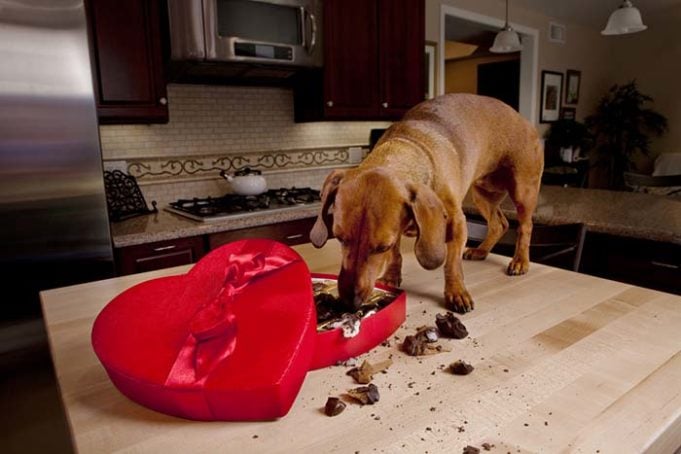Most dog owners are aware that chocolate can be toxic to dogs. However, even with all the necessary precautions, our pets sometimes find a way to get their paws on chocolate. In fact, chocolate is often among the top 10 toxins that dogs are treated for, according to the Animal Poison Control Center. Last year, chocolate poisoning was ranked fifth on the list, with 17,540 cases that year, or around 48 cases per day.
These statistics show that even with awareness of the dangers of chocolate for dogs, accidents still happen on a regular basis. It's important not only to know that chocolate is bad for dogs, but also what to do if your dog eats chocolate, so let’s take a look at detailed steps to take if this happens to you and your pooch.
1. Get Your Dog Away from the Chocolate
Get all the chocolate that’s left away from your dog. Make sure that there isn’t any chocolate left on the floor, on the counters or the surrounding area.
Check your dog’s mouth for any chocolate that you can remove, as well as wrappers that might choke your dog.
2. Assess Your Dog’s Condition
The first thing to do once you make sure there is no chocolate left for your dog to eat is to assess the pet's condition before you call your vet for advice. That means getting all the information you can about the type and amount of chocolate your dog ingested and looking for any symptoms of poisoning.
Animal Poison Control – (888) 426-4435
If you are not sure about how much chocolate your dog ate or if you notice any poisoning symptoms, it is best to call your vet or animal poison control hotline immediately.
3. Determine the Toxicity Level of Chocolate Ingested
 While all types of chocolate and other cocoa products are toxic to dogs, some are more dangerous than others. All of them contain theobromine, a substance that makes chocolate toxic to dogs.
While all types of chocolate and other cocoa products are toxic to dogs, some are more dangerous than others. All of them contain theobromine, a substance that makes chocolate toxic to dogs.
Milk and white chocolate are the least dangerous because they have the lowest levels of theobromine. Dark and cooking chocolate have the highest levels of this substance, which makes them more dangerous.
Pay attention to any filings the chocolate may have had, especially macadamia nuts or raisins since both of them are also extremely toxic to dogs.
Your dog’s weight also matters. It takes much less chocolate to poison a small dog, like Chihuahua, than it would take to poison a large breed, like Labrador Retriever. There's a special toxicity calculator you can use if you are not sure about toxicity levels of the chocolate your dog ate.
4. Look for the Symptoms of Poisoning
Pay attention to any signs of chocolate poisoning your dog may show. That way you can determine whether he is in immediate danger.
Symptoms of chocolate poisoning usually take 6 to 12 hours to show but that all depends on the type and amount of chocolate ingested. Symptoms may last for up to 72 hours and include diarrhea, vomiting, panting, shaking, hyperactivity, increased water consumption and urination, and seizures.
If you notice any of these symptoms, the safest thing to do is to take your dog to the vet immediately. If you didn’t call your vet or animal poison control hotline and explained the situation beforehand, take any remaining packaging from the chocolate your dog ingested with you to help veterinarians understand the problem better and determine the toxicity level and the best course of action.
How to Treat Chocolate Poisoning in Dogs
After you access the situation and get in touch with veterinarians, they will give you advice on how to proceed. Usually, if there are no serious symptoms or you know that your dog didn’t eat a dangerous amount, the vet will recommend monitoring him for the next couple of days.
If the vet thinks that your dog is in danger, he will either tell you to induce vomiting or get your pooch hospitalized.
How to Induce Vomiting
Dogs that ingest chocolate will often start to vomit on their own. However, it may be necessary for you to help them out and induce vomiting in the dog to get the toxins out.
Give Your Dog Hydrogen Peroxide
This should only be done after consultation with your vet and if your dog has ingested chocolate within the last hour and shows no neurological symptoms yet. In most cases, your vet will recommend taking the dog to his office so he can do it himself but you may have to do it on your own if you are not close to the vet’s office.
Give your dog one teaspoon of hydrogen peroxide to induce vomiting. You can mix it with water or ice-cream to entice your dog to ingest it and make it easier to swallow. If you mix it with water, stick to the 50:50 ratio. Use the oral dosing syringe if you have it in your dog’s emergency kit since it may be difficult to avoid spilling if you try to use a spoon.
Take Your Dog Outside
Get your dog moving after you give him hydrogen peroxide. Take him out for a walk for about 15-30 minutes. Physical activity can help to induce vomiting. It is also better to have your dog outside when he starts to vomit.
If your dog didn’t vomit after half an hour, don’t give him any more hydrogen peroxide. It can be dangerous and cause serious digestive problems if you give him too much.
Get your dog to eat some grass when outside. Dogs do this naturally when they want to induce vomiting after they eat something that doesn’t agree with their digestive system.
Give Your Dog Activated Charcoal
 Giving your dog activated charcoal should be the last resource. In fact, it is rarely recommended by ASPCA Animal Poison Control Center because it can cause hypernatremia, which is another name for high sodium levels in the blood. That’s why it is reserved for high-dose cases where vomiting couldn’t be induced and only if your vet recommends it.
Giving your dog activated charcoal should be the last resource. In fact, it is rarely recommended by ASPCA Animal Poison Control Center because it can cause hypernatremia, which is another name for high sodium levels in the blood. That’s why it is reserved for high-dose cases where vomiting couldn’t be induced and only if your vet recommends it.
Activated charcoal can prevent the absorption of the toxic substances from the chocolate. Give your dog a dose of 1 gram of charcoal powder mixed with one teaspoon of water per 2 pounds of body weight. Don’t give activated charcoal to a dog that shows neurological symptoms like tremors or seizures.
Mix the charcoal with a little canned food if your dog doesn’t want to eat it on his own. You can also use a syringe to make it easier but keep in mind that this raises a risk of charcoal getting in your dog’s lungs, which can even be fatal.
Dilute the Chocolate
If you are not able to get your dog to vomit, feed him something that he loves to eat. This can dilute the chocolate in his system and decrease the potency of the harmful substances. It’s also thought that boiled milk that’s been cooled may help with the dilution of the chocolate.
Take Your Dog to the Vet
It may be necessary to take your dog to the vet if you are not able to induce vomiting. Once you take him to the vet, he will be given IV fluids to help with the elimination of toxins and to ensure your dog stays hydrated.
If there are any neurological symptoms present, your vet will address them. He may give him medications like diazepam, midazolam, methocarbamol or acepromazine. Beta-blocker like propranolol may also be used if your dog shows signs of arrhythmia.
Conclusion
Chocolate poisoning in dogs is one of the most common types. It can be a serious, life-threatening issue, depending on the type and amount of chocolate ingested, as well as your dog’s weight.
It's crucial that you know what to do if your dog eats chocolate and how to react appropriately. If you know or suspect that your dog ate chocolate, get in touch with your vet and follow his instructions. You can also call the ASPCA Animal Poison Control Center by calling (888) 426-4435 for assistance.
READ NEXT: 7 Hidden Toxins in Your House That’re Poisonous or Cancerous to Dogs














